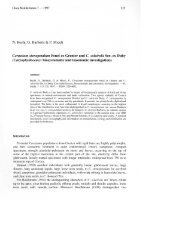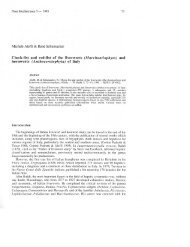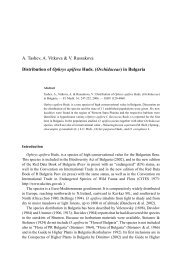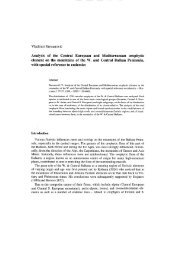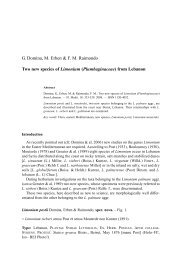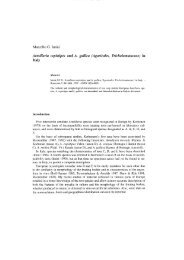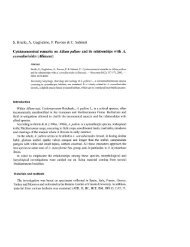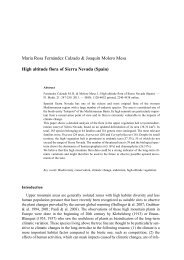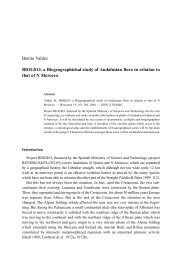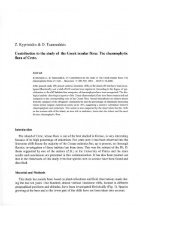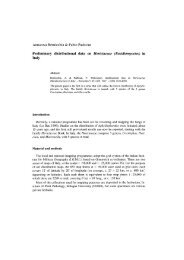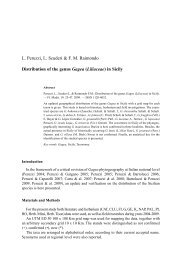Christoph Oberprieler The Systematics of Anthemis L. - Herbmedit.org
Christoph Oberprieler The Systematics of Anthemis L. - Herbmedit.org
Christoph Oberprieler The Systematics of Anthemis L. - Herbmedit.org
You also want an ePaper? Increase the reach of your titles
YUMPU automatically turns print PDFs into web optimized ePapers that Google loves.
14 <strong>Oberprieler</strong>: <strong>Anthemis</strong> in N Africa<br />
sive morphological and c1adistic study, no deliberate choice is made here between the two<br />
proposed scenarios, but for practical purposes the c1assification proposed by Fernandes<br />
(1975b, 1976) is provisionally followed.<br />
6. Phytogeography<br />
<strong>The</strong> total geographical range <strong>of</strong> <strong>Anthemis</strong> encompasses almost the whole western Eurasia,<br />
the Mediterranean, and a small part <strong>of</strong> E Africa. According to Meusel & Higer (1992)<br />
the distribution range is very similar to those <strong>of</strong> Daucus, Cichorium, and Filago. While C<br />
Europe is inhabited by few archaeophytic species only, the mai n centre <strong>of</strong> diversity is<br />
found in SW Asia where about 150 <strong>of</strong> the c. 210 described species occur and all <strong>of</strong> the<br />
presently accepted subgenera and sections are found. <strong>The</strong> W and C North African part <strong>of</strong><br />
the distribution area, which is covered by the present revision, hosts a markedly lower<br />
number <strong>of</strong> species and certainly has played a rather peripheral role in the evolution <strong>of</strong> the<br />
genus.<br />
<strong>Anthemis</strong> sect. Hiorthia, formed by perenni al herbs and subshrubs <strong>of</strong> predominantly<br />
mountainous habitats and <strong>of</strong>ten considered to be the most primitive section <strong>of</strong> <strong>Anthemis</strong>,<br />
shows a marked centre <strong>of</strong> diversity in SW Asia (Turkey and the adjacent Caucasus countries)<br />
and the mediterranean and submediterranean parts <strong>of</strong> SE Europe. According to<br />
Kuzmanov & al. (1981), Asia Minor is considered the primary evolutionary centre <strong>of</strong> the<br />
genus in generai and <strong>of</strong> A. sect. Hiorthia in particular, since diploid representatives <strong>of</strong> this<br />
section, in which polyploidy occurs, are concentrated here. While most <strong>of</strong> the SW Asian<br />
and SE European species <strong>of</strong> A. sect. Hiorthia are restricted to small areas, the highly<br />
polymorphic A. eretica (inc1uding A. carpatica and A. saxatilis) which is represented in<br />
Turkey by not less than 12 subspecies (Grierson & Yavin 1975) extends to C and even W<br />
southern Europe, and A. eretica subsp. columnae, a subspecies which is centred on the<br />
Balkan Peninsula and Italy, even occurs in Algeria in an extremely restricted area. <strong>The</strong><br />
distribution range <strong>of</strong> three other N African members <strong>of</strong> A. sect. Hiorthia, A. maritima,<br />
A. pedunculata, and A. abylaea, contrasts markedly with the pattern just described for<br />
A. eretica. A. maritima is restricted to the W Mediterranean area and, due to its deviating<br />
ecology, presumably represents a evolutionallineage quite independent from the remainder<br />
<strong>of</strong> the section. Additionally, diploid plants are found scattered throughout the distribution<br />
range <strong>of</strong> the species (Menorca, Benedi' i Gonzales 1987; Algeria, A. maritima subsp.<br />
bolosii, present paper). Similarly, the Ibero-Maghrebine A. pedunculata is also restricted<br />
to the W Mediterranean region and occurs at the diploid and tetraploid level. <strong>The</strong> deviating<br />
fruit morphology, with achenes circular instead <strong>of</strong> rhombic in cross-section, again<br />
suggests that A. pedunculata and its c10se tetraploid relative A. abylaea evolved independently<br />
from the remainder <strong>of</strong> the section. An obvious pattern <strong>of</strong> vicariance within A. sect.<br />
Hiorthia thus emerges, with a main centre <strong>of</strong> diversity in SW Asia and a minor centre<br />
formed by the lineages <strong>of</strong> A. maritima, A. pedunculata, and the Spanish diploid<br />
A. alpestris in the W Mediterranean area. <strong>The</strong> tetraploid NE Algerian and N Tunisian<br />
A. punctata, the fifth N African species <strong>of</strong> A. sect. Hiorthia, geographically links<br />
A. pedunculata with the A. eretica group (the Sicilian endemic species A. cupaniana and<br />
A. eretica subsp. columnae), being restricted to the area where the two lineages overlap.



